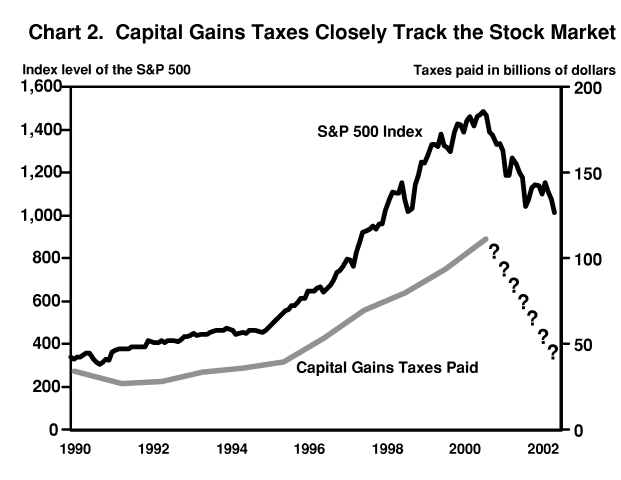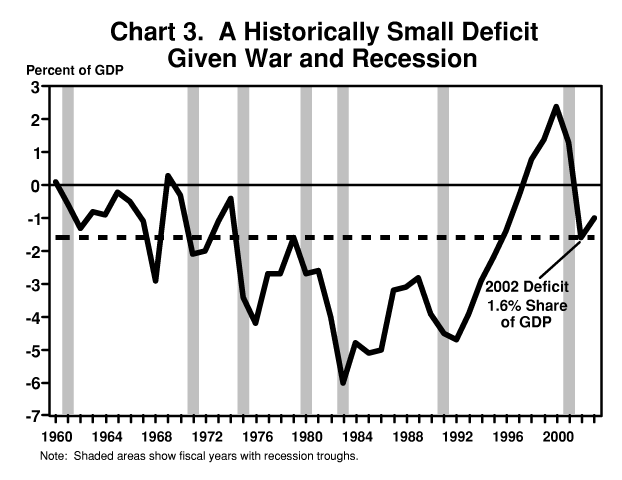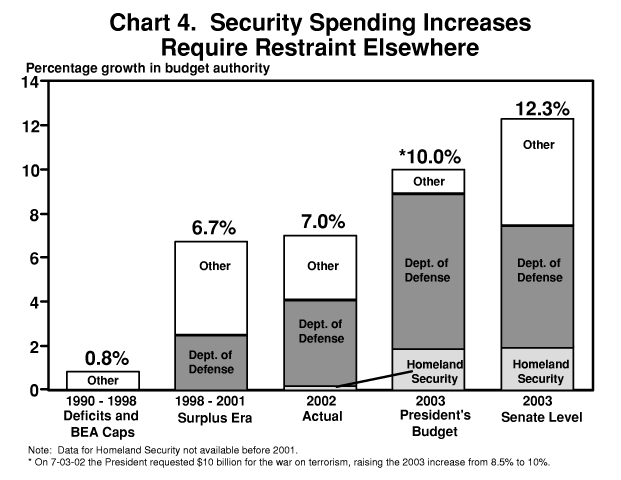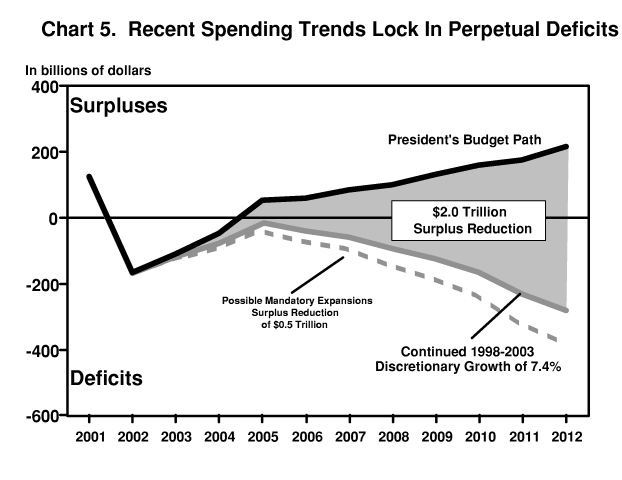SUMMARY
When this report was published last year, the nation was in the midst of a recession that, predictably, was already having detrimental effects on the government's finances. What no one could predict was that just 20 days later, a lethal attack on America would exacerbate the recession and trigger extraordinary military, homeland defense, and repair expenditures that would at least temporarily make an enormous difference in the fiscal outlook.
By the February 2002 submission of the Budget for fiscal year 2003, the budgetary effects of the recession and the war on terror were well understood. It was also becoming apparent that the flood of revenue that produced record surpluses in the late 1990s was driven both by underlying economic growth, the traditionally decisive factor, and, in ways not yet fully grasped, by the extraordinary boom in the stock market. The markedly greater dependence of revenues on stock market developments was not yet understood by experts either inside or outside the government.
The economic recovery appears to be underway, the one-time costs of recovery are being paid, and the expense of war-fighting abroad and new protective resources at home have been incorporated in budget plans. Taking all these changes into account, the federal government is now projected to spend $165 billion more than it receives in revenues in 2002, up from the $106 billion projected nearly six months ago. Table 1 below comparing February and July estimates shows a return to the pre-recession pattern of surpluses in 2005, and growing surpluses thereafter. Future improvements, however, depend to a significant extent on two key factors: 1) restraint of the recent rapid growth in federal spending; and 2) a resumption of growth in tax payments produced by a stronger economy and a stronger stock market.
| 2002 | 2003 | 2004 | 2005 | 2006 | 2007 | 2003–2007 | |
|---|---|---|---|---|---|---|---|
| 2003 Budget policy surplus | -106 | -80 | -14 | 61 | 86 | 104 | 157 |
| Enacted legislation | 34 | 33 | 17 | 33 | 4 | 2 | 89 |
| Supplemental and other adjustments to Administration policy | -13 | -7 | -6 | -3 | -4 | -3 | -25 |
| Economic and technical reestimates | -80 | -54 | -45 | -37 | -26 | -18 | -181 |
| Total changes | -59 | -29 | -34 | -8 | -26 | -20 | -117 |
| Mid-Session Review policy surplus | -165 | -109 | -48 | 53 | 60 | 84 | 41 |
Moving Forward Amid the Backdrop of War
President Bush placed two purposes above all others in his 2003 Budget: Winning the war on terror and restoring the economy to health. On both fronts, initial progress has been encouraging. Military action in Afghanistan has depleted the ranks and greatly weakened the operational capabilities of the terrorists. On the economic front, the nation's gross domestic product (GDP) grew at an impressive 6.1 percent annual rate in the first quarter of 2002, making the recession both shorter and shallower than most and the early recovery far stronger than assumed in February's budget.

|
For the future, we can be certain only of the intentions of our adversaries and our own resolve to defeat them. We know neither the length of the conflict nor the budgetary expense of victory. Nor can we be certain the economy will not be weakened by further shocks. To preserve the flexibility to respond to future events while maintaining a fiscal framework that will return the budget to surplus, it is imperative that spending, especially on programs not related to the primary objectives of the 2003 Budget, be tightly restrained.
Emergencies and Response Increase Outlays
In late March 2002, President Bush requested that Congress provide an additional $27.1 billion, primarily for our efforts in the war against terror. More than half of this amount would fund the war-fighting activities of the Department of Defense and the intelligence community. The major remaining portions of the supplemental request are needed for homeland security, mainly in the new Transportation Security Administration, and for emergency response and recovery efforts in New York City. Most of this spending is one-time in character and will not be continued in future years.
In June, President Bush called on Congress to create the Department of Homeland Security to meet the new threats to our nation's security more effectively. Homeland security responsibilities are now spread among 100 government entities. The new Cabinet agency will be organized to better safeguard against threats at home by integrating similar functions, streamlining communications, coordinating systems, and allowing more comprehensive planning.
Responding to the Effects of Recession
The economic impact of the September 11th attacks and the recession they deepened exacted an additional toll on federal receipts. This impact was partly ameliorated by enactment in June 2001 of the President's tax relief program. As Chart 1 shows, tax relief brought individual income taxes as a share of GDP back from its recent all-time high. Were it not for the recession, receipts would still be historically high despite the tax cut, and will increase again as the economic recovery proceeds.
"For once, Congress managed to implement a contra-cyclical fiscal policy that should boost economic growth exactly when the economy needs it," said Merrill Lynch's Bruce Steinberg around the time the tax relief bill was passed. Martin Feldstein, president of the authoritative National Bureau of Economic Research, called the subsequent economic turnaround "neither an illusion nor an accident," adding that "[a] primary reason for the strength of consumer spending was the enactment of the tax cut in early 2001." Congressional Budget Office (CBO) Director Dan L. Crippen told the Senate Budget Committee in January, "[T]he tax cuts enacted in June prevented consumption from slowing more than it might have otherwise . . ."
President Bush called on the Congress in the Fall of 2001 to enact a further tax stimulus program to counteract the recession. Congress responded in March by enacting the Job Creation and Worker Assistance Act. The central feature of this Act was a set of temporary provisions to encourage business investment. Specifically, the Act permits firms to write off 30 percent of the value of their qualified investments in the year of purchase. To help ease the financial pressure on Americans directly affected by the recession, the law also extended for 13 weeks the unemployment benefits available to those who remained out of work since the onset of the recession.
The Fall of Receipts
The recession also meant that funds flowing into the Treasury fell substantially. Receipts in 2002 are now estimated to decline outright by $124 billion, or six percent, from 2001 levels. The last time revenues fell to that extent was in 1955.
The current shortfall represents the mirror image of the revenue explosion of recent years. From 1995 to 2000, federal receipts grew at an average annual rate of more than eight percent, from $1.4 trillion to $2.0 trillion. Growth in total receipts exceeded overall economic growth, driving up the ratio of receipts to GDP, or tax share, from 18.5 percent to 20.8 percent, a peacetime record. The rise in total receipts was driven largely by increases in individual income taxes.
Strong real personal income growth was responsible for some of the rise in the tax share during the late 1990s. The taxable components of personal income per capita rose 6.8 percent annually from 1995 to 2000, far exceeding the average 2.5 percent increase in the Consumer Price Index over this period. An analysis of the period 1995–99 by CBO estimates that when measured by adjusted gross income this real income growth, by pushing workers into higher tax brackets, accounted for just under a third of the rise in the share of individual taxes to GDP.
The strength in individual income tax receipts traced very directly to a period of remarkable stock market gains. Estimated capital gains tax payments almost tripled from $40 billion in 1995 to $118 billion in 2000, rising as a share of GDP from 0.5 percent to 1.2 percent. Thus, while capital gains receipts are a small portion of overall revenues, they accounted for roughly one-third of the rise in the tax share over this period. The leap in realized capital gains was driven primarily by the rise in the stock market, but also by the development of inexpensive trading accounts.
The stock market's rise also increased the value of assets held in tax deferred accounts. The value of these accounts rose from $6 trillion in 1994 to $11.7 trillion in 2000. Withdrawals from these accounts are taxed as ordinary income. CBO estimates that growth in taxes paid on retirement withdrawals, Social Security benefits, and other sources accounts for roughly 10 percent of the increase in the ratio of individual income taxes to GDP in the late 1990s.
After surging for more than seven years, revenue growth slowed dramatically in 2001, even before accounting for the 2001 tax relief act, and then fell in 2002. The reversal was driven predominantly by the recession and the stock market's decline. Moreover, the drop in receipts has been notably larger than the decline in economic growth. The difference between receipts growth and GDP growth in 2002, even after adjustments for the 2001 tax relief and the 2002 stimulus act, is projected to reach eight percentage points. This is a much larger divergence than during the 1990–91 recession, even when adjusted for tax legislation at that time. The current receipts situation is similar to those experienced during the far more severe recessions of the 1970s and early 1980s.
Individual income taxes, as opposed to payroll taxes, corporate taxes, or other forms of revenue, account for nearly all of this year's projected drop in receipts. Through May, so-called "non-withheld payments" (largely the final tax payments submitted with April 15th tax returns) were down $80 billion, or 28 percent, from this time last year. Such payments commonly are owed on capital gains from equities, mutual fund distributions, and small business income. Likewise, refunds were up $31 billion, or 23 percent, from last year. Workers who had too much tax withheld from their paychecks, and capital losses suffered by investors are thought to be the main explanations behind the jump in refunds.
The precise causes of this year's income tax drop-off will not be known for some time. However, since taxes on capital gains are often not paid until the April 15th deadline, the size and timing of the decline in receipts through May strongly point to a dramatic decline in net capital gains realizations. (Further discussion of the stock market's impact on revenue appears in the following box and in Chart 2.)

|
The Growing Role of the Stock Market in Federal Receipts
|
Uncertainties in Long-Term Budget Forecasts
As documented in the February budget submission, the exercise of producing 10-year budget forecasts is fraught with problems. Budget forecasters have trouble making accurate predictions for the upcoming year, much less 10 years into the future. Despite the clear deficiencies, some have applied a benchmark status to the 10-year forecast the Administration made over a year ago.
In February 2001, the Administration issued a "baseline" projection reporting that the federal government would run surpluses totaling $5.6 trillion from 2002 to 2011. Like all baseline projections, this one was predicated on three major assumptions:
1) That the economy would perform as expected;
2) That no significant events would alter the budget outlook; and
3) That no policy changes would take place for 10 years.
Obviously, the Administration intended numerous policy changes, the first of which were presented in the February 2001 Budget. The other two assumptions were undermined by events.
| 2002 | 2003 | 2002–2011 | |
|---|---|---|---|
| February 2001 baseline surplus | 283 | 334 | 5,637 |
| Economic and technical reestimates | -278 | -194 | -1,669 |
| Enacted policy: | |||
| Tax relief | -41 | -94 | -1,491 |
| Other enacted legislation | -115 | -107 | -760 |
| Subtotal, enacted policy | -156 | -202 | -2,251 |
| President's budget proposals | -15 | -47 | -1,273 |
| Total change | -448 | -443 | -5,193 |
| Mid-Session Review policy surplus | -165 | -109 | 444 |
The economy had shown signs of stagnating throughout 2000. For example, the stock market began to decline in March 2000, followed by collapsing business investment by the end of the year, and higher unemployment rolls beginning in early 2001. The economy entered official recession in March 2001.
The recession's profound effect was the largest factor changing the projected long-term budget surplus. The $1.7 trillion change in the projected cumulative surplus is due to economically driven lower receipts. This change reflects the recession's immediate impact and a more cautious outlook about long-term revenues.
Other external events had an obvious and dramatic impact on the budget. The September 11th terrorist attacks on New York City, on Washington, and in the Pennsylvania skies had the dual fiscal effect of deepening the recession and requiring unplanned spending of tens of billions of dollars to recover and to protect against future attacks. Spending in response to those attacks, the additional deadly assaults carried out with anthrax, and the necessary additional increases in defense and homeland security spending further reduced projected surpluses.
The assumption of no new policy is, of course, just a budgeting convention. Some policy changes were intended at the Administration's inception; changed circumstances have prompted other shifts.
The surplus also changed because the President believed that some portion of it should be returned to the taxpayers. Prior to 2001, he called for tax relief to strengthen the economy in the long run, and stated his concern about the possibility of economic slowdown in the near term. Congress agreed and enacted the bipartisan Economic Growth and Tax Relief Reconciliation Act (EGTRRA) in June 2001. This legislation changed the 10-year projected surplus by $1.5 trillion from 2002 to 2011. Its impact in 2002 was very limited, accounting for less than 10 percent of the $448 billion total shift in expected surpluses for 2002. (See Table 2 for details.) Clearly, the tax cut did not eliminate the surplus, and, in fact, was remarkably well-timed and well-designed for addressing the recession.
The President's February 2001 Budget also included some new spending measures, for example, the costs associated with the President's Medicare prescription drug proposal, his education reforms, and his initial defense rebuilding proposals. Collectively, these three initiatives would combine to reduce estimated surpluses by approximately $300 billion.
A further impact came from higher than planned discretionary appropriations for 2002, and this year's economic stimulus and farm bills. The latest projected surplus for the 2002–11 period is $444 billion. (For the 10 years 2003–12, that figure grows to $827 billion.) Even this amount depends on congressional adherence to the President's call for spending discipline.
The 10-year, $5.6 trillion baseline surplus projection was a good-faith estimate, consistent with CBO and contemporary forecasts, which also assumed no programmatic changes, no recession, no September 11th, and no war on terror. The 2001 tax cut was the correct fiscal policy response to the recession, had little effect on short-term surpluses, and is not the predominant cause of the reduction in the projected surplus.
An Improved Economic Outlook Over the Horizon
The combination of higher spending necessitated by the attacks of September 11th and lower than expected receipts meant a sharp fiscal reversal from the $127 billion surplus posted in 2001. Nonetheless, the deficit as a percentage of GDP is small historically, as Chart 3 shows.

|
This period in deficit should be brief, because economic fundamentals have stayed strong. The budget outlook for 2003 is more favorable than 2002, assuming overall spending growth is held to a more sustainable five percent. With a rebound in receipts from depressed 2002 levels, the projected deficit for 2003 is $109 billion, down from $165 billion currently projected for 2002. The pattern is repeated in fiscal year 2004, where four percent spending growth coupled with seven percent revenue growth reduces the deficit to $48 billion.
Current estimates show a return to surplus in 2005. The strong fundamentals of the U.S. economy—low inflation, strong productivity growth, and a healthy labor market—should combine to deliver growing surpluses and the opportunity to resume paying down the national debt in the years beyond.
Spending Restraint Is Key
The budget outlook, as always, is subject to innumerable uncertainties. New developments or a widening of the war on terror may require additional outlays, potentially for years to come. A weaker economy than projected may lead to additional revenue disappointments, whereas a resurgent stock market may reverse the recent declines in net capital gains receipts. These still-unfolding events provide new reasons to dispense with the misplaced emphasis on 10-year budget projections, as the Administration has previously suggested. Even the latter years contained in five-year estimates, which the Administration is required by statute to present, must be viewed warily.
Despite these uncertainties, the risks remain manageable, provided policymakers exercise appropriate discipline. Overall non-emergency discretionary budget authority for 2002 is up an estimated $45 billion, or seven percent, from 2001. If one includes emergency appropriations in response to September 11th and the Administration's proposed supplemental funding, discretionary budget authority rises $72 billion, or 11 percent, from 2001. Overall outlays are up an estimated $169 billion, or nine percent, from 2001, of which $36 billion is the result of emergency appropriations in response to September 11th, including the Administration's proposed supplemental funding. The risks to our long-term fiscal health will decline greatly if policymakers act to slow the recent rapid growth in discretionary spending. Overall appropriations have been allowed to grow an average of seven percent annually since 1998. Chart 4 shows pressures for continued rapid spending growth have not subsided even amid the new fiscal realities.

|
Achieving the restrained spending growth detailed in the President's Budget is essential if we are to return to budget balance. To that end, the Administration renews its call for legally enforceable budget discipline tools, such as making the budget resolution law and reimposing caps on overall spending levels.

|
Even absent the budgetary demands of war and the need to return to balance, fiscal discipline is needed to address looming fiscal threats posed by entitlement, or mandatory, spending growth. For the moment, Medicare and Social Security spending, both of which are estimated to increase by approximately 4.5 percent in 2003, help to moderate total federal spending growth rates. Other mandatory spending programs, such as agricultural and veterans spending, are growing more rapidly.
With the recent enactment of the farm bill, mandatory agriculture commodity and conservation spending will increase by an estimated 25 percent in 2003. Veterans mandatory spending is projected to increase by 15 percent. Even so, Congress is considering significant expansions in agriculture for drought assistance, in Medicare, and in veterans mandatory spending. As Chart 5 illustrates, continued unconstrained growth in discretionary spending and expansion in mandatory spending would eliminate any hope of balanced budgets, let alone surpluses and debt reduction.
In the long run, Social Security, Medicare, and Medicaid spending will accelerate with the retirement of the baby boom generation. The President has proposed a long-term reform plan for Medicare that includes a prescription drug benefit. Meanwhile, the President's Commission on Social Security Reform confirmed what others have demonstrated: the Social Security system is heading for acute financial difficulties in the not-too-distant future.
It bears repeating: a return to balanced budgets depends on slowing the recent growth in discretionary spending. Just as interest compounds rapidly to the benefit of savers, so, too, does incremental spending compound to add dramatically to future outlays. Chart 5 illustrates the effect, with the widening difference between the current spending course and the President's budgetary path amounting to $2 trillion by 2012. The problem is exacerbated by the unfortunate illogic through which each program's funding level this year is treated as the starting point for next year's budget deliberations. The effect is a bias toward increasing spending, with too little attention given to identifying what works, what doesn't, and what isn't worth keeping at all. Measuring and acting on the performance of government programs is a major point of emphasis for the Administration. This initiative, long sought by government reform advocates, must culminate in a commitment to make these practices routine and their contributions to better government permanent.
The kind of restraint the President has called for should not be difficult to achieve. Most states are demonstrating it now. Overall state spending growth for 2002 was held to two percent, the same figure the President has recommended for non-war, non-homeland defense activities. Governors' proposed budgets for 2003 collectively foresee a 1.4 percent rise in spending, the smallest since 1983.
For now, the fundamentals of the economy and the federal government's fiscal outlook remain strong. The best way to protect both, as we do what we must to defend the lives of Americans, is to approach all other governmental spending increases with great caution in the years directly ahead.
